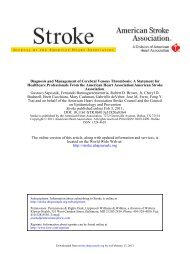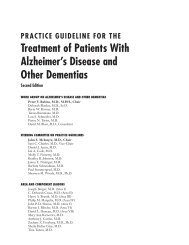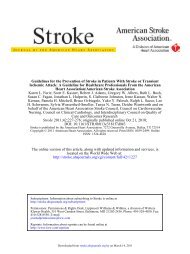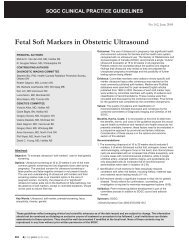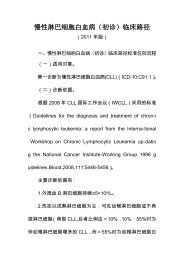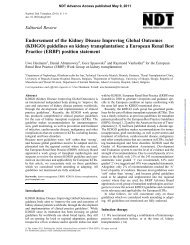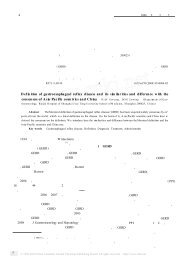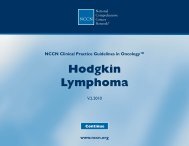EFNS guidelines on pharmacological treatment of neuropathic pain
EFNS guidelines on pharmacological treatment of neuropathic pain
EFNS guidelines on pharmacological treatment of neuropathic pain
Create successful ePaper yourself
Turn your PDF publications into a flip-book with our unique Google optimized e-Paper software.
1154 N. Attal et al.The objectives <strong>of</strong> our Task Force were: (1) to examineall the RCTs performed in the various <strong>neuropathic</strong><strong>pain</strong> c<strong>on</strong>diti<strong>on</strong>s; (2) to evaluate the drug effects <strong>on</strong> <strong>pain</strong>symptoms, quality <strong>of</strong> life, and sleep, and the adverseevents; (3) to propose recommendati<strong>on</strong>s based <strong>on</strong> theresults <strong>of</strong> these trials aiming at helping clinicians in their<strong>treatment</strong> choice for most <strong>neuropathic</strong> <strong>pain</strong> c<strong>on</strong>diti<strong>on</strong>s;(4) to propose new studies that may help clarify unsolvedissues.MethodsWe c<strong>on</strong>ducted an initial search through the centraldatabase in the Cochrane Library. Whenever theCochrane search failed to find top level studies for agiven <strong>neuropathic</strong> <strong>pain</strong> c<strong>on</strong>diti<strong>on</strong> or a drug which wassupposedly active <strong>on</strong> <strong>neuropathic</strong> <strong>pain</strong>, we expanded thesearch using Medline and other electr<strong>on</strong>ic databases(1966–to date), and checking reference lists published inmeta-analyses, review articles, and other clinical reports.Furthermore, to get the most updated informati<strong>on</strong>, wealso asked all the pharmaceutical companies producingdrugs in this field to provide us with studies not yetpublished (Appendix A). Any reports retrieved fromthese c<strong>on</strong>tacts were pooled with the others for selecti<strong>on</strong>.In order to provide the neurologist with clear indicati<strong>on</strong>sregarding drug <strong>treatment</strong> for the most studied<strong>neuropathic</strong> <strong>pain</strong>s, the Task Force decided to produceindividual chapters for <strong>pain</strong>ful polyneuropathies, PHN,TN, and CP [spinal cord injury (SCI), post-stroke <strong>pain</strong>and multiple sclerosis (MS)], but to search and reportalso for the other less studied <strong>neuropathic</strong> c<strong>on</strong>diti<strong>on</strong>s(post-traumatic/post-surgical nerve lesi<strong>on</strong>s, phantomlimb <strong>pain</strong>, Guillain–Barre´ syndrome) and for <strong>neuropathic</strong><strong>pain</strong>s with multiple aetiology. Each chapter wasassigned to two Task Force participants.least 1 week; (6) <strong>treatment</strong> feasible in an outpatient setting(i.v., subcutaneous, or intrathecal therapy or nerveblocks were not c<strong>on</strong>sidered); (7) evaluating currentlyused drugs or drugs under clinical phase-III development:(8) including patients with <strong>pain</strong> sec<strong>on</strong>dary to adefinite nervous system lesi<strong>on</strong>/disease [13] or idiopathicTN; (9) full paper citati<strong>on</strong>s in English, Danish, French,Finnish, German, Italian, Portuguese or Spanish.Exclusi<strong>on</strong> criteria were duplicated patient series,unc<strong>on</strong>trolled studies, <strong>pain</strong> without evidence <strong>of</strong> a nervelesi<strong>on</strong>, such as atypical facial <strong>pain</strong>, CRPS type I or lowback <strong>pain</strong>, n<strong>on</strong>-validated or unc<strong>on</strong>venti<strong>on</strong>al outcomemeasures, n<strong>on</strong>-<strong>pharmacological</strong> interventi<strong>on</strong>, <strong>treatment</strong>sacting directly <strong>on</strong> the disease or pre-emptive <strong>treatment</strong>s.Informati<strong>on</strong> selected from the trialsFrom articles meeting our search criteria, we extractedinformati<strong>on</strong> regarding the efficacy not <strong>on</strong>ly <strong>on</strong>overall <strong>pain</strong> and main side-effects, but also effects <strong>on</strong><strong>pain</strong> symptoms or signs, quality <strong>of</strong> life and mood,whenever available. We also referred to recent wellc<strong>on</strong>ductedmeta-analyses when analysis <strong>of</strong> thesestudies did not provide with additi<strong>on</strong>al informati<strong>on</strong>regarding these end-points. We used the NNT (thenumber <strong>of</strong> patients needed to treat to obtain <strong>on</strong>eresp<strong>on</strong>der to the active drug) with 95% c<strong>on</strong>fidenceintervals (CI) for class I/II studies in order to gaininformati<strong>on</strong> regarding the overall efficacy <strong>of</strong> a drug.Unless otherwise specified, we used the NNT for 50%<strong>pain</strong> relief. These values were calculated for newertrials or extracted from recent meta-analyses performedby members <strong>of</strong> this Task Force [2,9,14] or theCochrane database [11,15–17]. We did not use theNumber Needed to Harm because <strong>of</strong> lack <strong>of</strong> uniformcriteria for assessing harmful events [2].Classificati<strong>on</strong> <strong>of</strong> evidenceClassificati<strong>on</strong> <strong>of</strong> evidence and recommendati<strong>on</strong> gradingadhered to the <str<strong>on</strong>g>EFNS</str<strong>on</strong>g> standards [12]. In particular, classI refers not <strong>on</strong>ly to adequate prospective RCTs, butalso to adequately powered SR.Inclusi<strong>on</strong> and exclusi<strong>on</strong> criteriaIncluded studies complied with the following criteria: (1)randomized or n<strong>on</strong>-randomized but c<strong>on</strong>trolled class I orII trials (lower-class studies were evaluated in c<strong>on</strong>diti<strong>on</strong>sin which no higher-level studies were available); (2) <strong>pain</strong>relief c<strong>on</strong>sidered as a primary outcome and measuredwith validated scales; (3) minimum sample <strong>of</strong> 10 patients;(4) <strong>treatment</strong> durati<strong>on</strong> and follow up clearly specified;(5) <strong>treatment</strong> assessed in repeated dose settings for atResultsPainful polyneuropathyPainful polyneuropathy (PPN) is a comm<strong>on</strong> <strong>neuropathic</strong><strong>pain</strong> c<strong>on</strong>diti<strong>on</strong>. Diabetic polyneuropathy is themost classical example. Patients usually present withsp<strong>on</strong>taneous and stimulus-evoked <strong>pain</strong>s with a distaland symmetrical distributi<strong>on</strong> [18]. Although <strong>on</strong>e ormore <strong>of</strong> the <strong>pain</strong> symptoms characteristics <strong>of</strong> <strong>neuropathic</strong>c<strong>on</strong>diti<strong>on</strong>s are seen in the majority <strong>of</strong> the patients,the most frequent single <strong>pain</strong> symptom is deepaching <strong>pain</strong> [18]. Diabetic and n<strong>on</strong>-diabetic PPN aresimilar in symptomatology and with respect to <strong>treatment</strong>resp<strong>on</strong>se [class I SR: 19]. The <strong>on</strong>ly excepti<strong>on</strong>sseem to c<strong>on</strong>cern HIV- and chemotherapy-inducedneuropathy which are described separately.Ó 2006 <str<strong>on</strong>g>EFNS</str<strong>on</strong>g> European Journal <strong>of</strong> Neurology 13, 1153–1169



